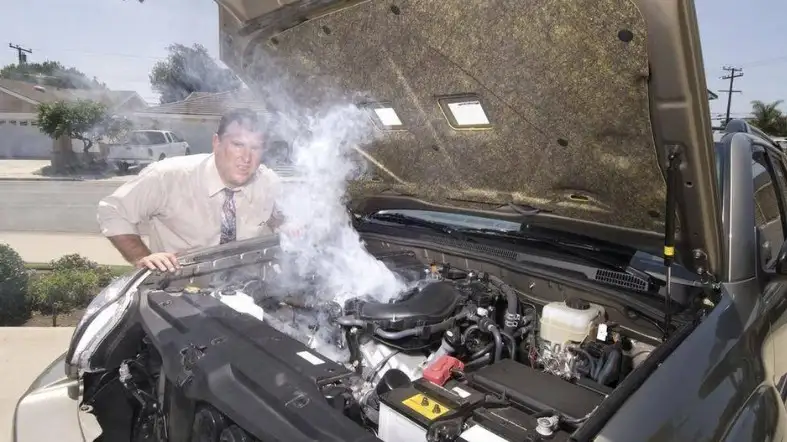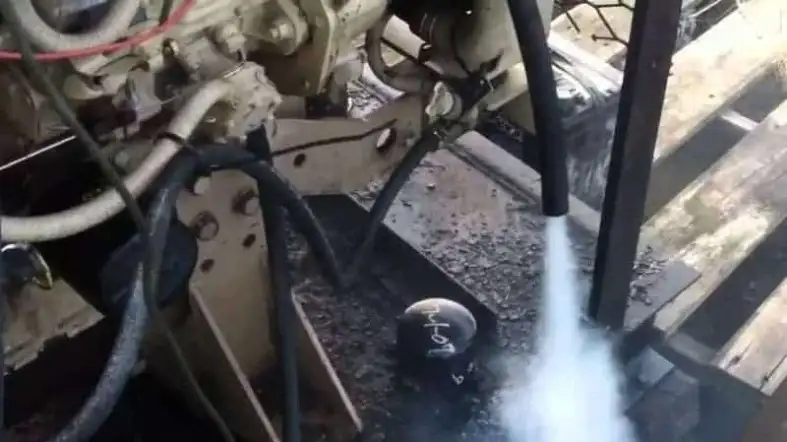Curious about how long an engine will last with a blow-by? Here we explore the factors influencing engine longevity, common misconceptions, and maintenance tips.
With severe blow-by, an engine might last 400 to 1,000 hours, but proactive care can extend its life.
Discover how to keep your engine running smoothly despite blow-by issues.

How long will an engine last with blow-by?
With severe blow-by, an engine might last 400 to 1,000 hours. However, the exact duration depends on the engine’s condition and maintenance. Regular checks and timely repairs can extend its life.
What is Engine Blow-By?
Gases such as water vapor, carbon dioxide, unburned gasoline, and air can escape past piston rings and end up in the crankcase, causing engine blow-by.
Modern engineering has lessened the severity of this old problem, but awareness is still essential.
Signs of Engine Blow-By
Smoke from Exhaust
An obvious sign of oil combustion in the cylinders is blue or gray smoke coming from the exhaust.
This happens when oil is driven into the cylinders by damaged valve seals or worn piston rings, increasing emissions and having a negative environmental impact.
Increased Oil Consumption
The PCV system helps manage the fumes and oil vapor produced by the engine.
When these fumes and oil vapor are not handled properly, it can lead to your engine using more oil.
This means you’ll have to add oil to your engine more often.
Reduced Engine Power
A lower compression ratio is the result of blow-by gases entering the crankcase, which reduces the effectiveness of the compression stroke.
This decrease in compression has a negative impact on the engine’s overall performance, resulting in lessened power, sluggish acceleration, and reduced fuel efficiency.
Unusual Engine Noises
The pressure and vibrations produced by blow-by gases inside the crankcase cause audible signs like knocking, pinging, or hissing to occur.
These sounds are audible warning signs of internal pressure imbalances and frequently portend impending engine problems.
Poor Acceleration
The air-fuel combination is displaced by blow-by gases inside the combustion chamber, creating an insufficient mixture for burning.
Poor acceleration, decreased performance, and a general decrease in driving responsiveness are the symptoms of this deficit.
Excessive Crankcase Pressure
Blowing can increase the pressure inside the crankcase, forcing oil and gases through weaker places and leading to leaks.
This increased pressure also raises the risk of engine damage, such as weakened seals and failed gaskets.
Fouled Spark Plugs
Blow-by facilitates the entry of oil into the combustion chamber, coating spark plugs and causing fouling.
Fouled spark plugs lead to inefficient combustion, misfires, and a noticeable decline in engine performance.
Check Engine Light Activation
Modern engines come with sensors that can keep an eye on a number of characteristics.
The check engine light turns on to signal departures from expected values when abnormal blow-by gas levels are detected.
Causes of Engine Blow-By
Here are the causes of engine blow-by
Worn Piston Rings
Piston rings deteriorate over time as a result of combustion’s friction and heat.
Due to the gaps that this erosion leaves in the rings, high-pressure combustion gases can flow through and enter the crankcase.
Cylinder Wall Damage
Extended use, overheating, or insufficient lubrication can result in damage to the cylinder walls.
Such damage leads to uneven sealing, permitting combustion gases to escape into the crankcase.
Malfunctioning PCV Valve
A broken PCV valve can cause problems with the Positive Crankcase Ventilation (PCV) system, which is essential for keeping the crankcase pressure balanced.
Gas recirculation is hampered by valve clogging or breakage, leading to pressure imbalances and more blow-by.
Overpressurized Crankcase
Excessive blow-by gases or a faulty PCV valve can elevate crankcase pressure.
This heightened pressure forces oil and gases to escape through seals and gaskets, contributing to blow-by.
Faulty Valve Seals
Seals on valves that stop oil from entering the combustion chamber may deteriorate or crack.
Oil can enter the combustion chamber through worn or damaged valve seals, altering combustion and aggravating blow-by.
Damaged Gaskets
Gaskets, which act as seals between engine parts, can deteriorate or wear out.
Blowing-by problems are made worse by gas and oil leaks caused by damaged or worn gaskets.
Engine Wear and Tear
Normal wear and tear resulting from regular use leads to worn piston rings, cylinder walls, and various engine components.
Cumulative wear diminishes the engine’s sealing capabilities, contributing to blow-by.
Incorrect Engine Assembly
It is possible for mistakes to be made during the engine assembly process, such as component misalignment.
Blowing-by issues are made worse by poor assembly, which causes gaps and misalignments that cause gas and oil leaks
Effects of Blow-By on Engine Performance
Here are the effects of blow-by on engine performance:

Reduced Engine Power
Think of your engine like an athlete aiming for the top. Blowby places obstacles in its path.
Lower compression results when some combustion gases leak past the piston rings and into the crankcase.
Result? The power your engine is capable of producing is difficult to convey.
It’s comparable to a sportsperson jogging while wearing ankle weights. higher effort with decreased power.
Increased Oil Consumption
Your engine’s lifeblood, oil, and lubricate its parts to guarantee smooth functioning. This harmony is broken by blow-bys.
As these escaping gases combine with the engine oil, it drives your engine to use more oil than is necessary.
This increased oil use is comparable to your engine becoming insatiably thirsty. Less efficiency with more oil.
Excessive Smoke from Exhaust
Consider the exhaust as the vehicle’s means of communication. It becomes a smoke signal when a blow by occurs, and not a nice one.
Excessive smoke suggests internal problems and indicates incomplete combustion. It seems like your car is making an emergency call. A scream for rescue is smoke.
Poor Fuel Efficiency
The gold standard for an efficient engine is its fuel economy. This effectiveness is undermined by blow-by, which modifies the combustion process.
To make up for the diminished power output, more gasoline is needed, which reduces miles per gallon.
Like your car needs more fuel for the same amount of effort, you need more snacks to complete the task. Fewer miles, more fuel.
Elevated Emissions
Car emissions are a serious issue in the current era of environmental consciousness. Unburned hydrocarbons from blow-by are a contributing factor to the issue.
This affects not only your car but also the environment by upsetting the delicate balance of clean air. Air pollution is a danger to the Earth.
Potential Damage to Catalytic Converter
A protector against hazardous emissions is the catalytic converter. However, a blow-by could jeopardize this protector.
Blower-by contaminants reduce the converter’s efficiency, which could result in higher emissions and environmental harm.
It’s like a superhero losing their shield of protection. Enhanced risk and weakened defense.
Increased Wear on Engine Components
Consider your engine’s interior parts as precisely tuned instruments in an orchestra.
These parts are forced to work harder due to blow-by, which acts as a disruptive force and increases wear and tear.
Similar to musicians playing continuously without breaks, fatigue soon sets in. Engine compromise due to worn parts.
Decreased Overall Engine Lifespan
An engine is akin to a timeless masterpiece, designed for longevity. Blow by accelerates the aging process.
It’s akin to fast-forwarding the clock, causing premature wear and shortening the overall lifespan of your engine. Accelerated aging, shorter life.

Factors Influencing Engine Longevity with Blow-By
Here are the factors influencing engine longevity with blow-by
Engine Design and Build Quality
An automobile engine can be built similarly to a LEGO creation. Your design will be amazing if the components fit tightly together!
Similar to how a well-built engine is built to last. Longevity is greatly enhanced by the use of high-quality components and creative design.
Maintenance and Care
Cars need routine maintenance much like you clean your teeth for optimal health.
Regular tune-ups, oil changes, and air filter replacements are like a wellness check for your car.
It is not a good idea to ignore these fundamentals, similar to ignoring a chronic cough.
Severity and Duration of Blow-By
Here’s a quick scientific lesson! Engine gases slipping past piston rings cause blow-by. Too much of this gives your car a stomachache.
It raises a red signal if it happens frequently and over an extended period of time. Your engine will purr contentedly if you treat it nicely.
Environmental Conditions
Imagine enduring freezing cold or scorching heat – cars feel the same way. Extreme weather is harsh on engines.
Optimal conditions are like a warm blanket for your car. If possible, keep it cozy to extend its life.
Oil Quality and Usage
Oil is the lifeblood of your engine. Using top-notch oil is like munching on healthy snacks your body (or car) will thank you.
Also, keep an eye on the oil level. Too little oil is akin to running on an empty stomach.
Driving Habits and Conditions
Are you a speed devil or a smooth operator? The health of your car will benefit from careful driving.
Stop-and-go traffic is similar to forcing your car to perform jumping jacks. No way! Aim for calm seas; your engine will thank you for it.
Engine Load and Stress
Think of your car as a superhero. Every superhero has limits, right? Well, your car does too.
Heavy loads and towing add extra stress to your engine. So, be a hero – don’t overload your trusty sidekick!
Proactive Repairs and Mitigation Measures
Early problem-solving is similar to halting a little leak before it grows into a flood. Avoid waiting until your automobile starts to cough and splutter!
If you take care of those issues right away, your car will be a tough road warrior.
The Misconceptions About Engine Blow-By and Longevity

Can You Run Kerosene In A Diesel Engine?
Common Misunderstandings
First things first, what’s Engine Blow-By? Some folks think it’s a scary thing that ruins cars, but that’s not entirely true.
Blow-by happens when a tiny bit of exhaust sneaks past the pistons in an engine. Don’t worry, it’s normal!
Impact on Longevity: Debunking Myths
The exciting part is right here. Some people think that blow-by acts as an engine time bomb for automobiles, ready to detonate at any moment. Let’s check the facts, though, first.
According to studies, minor levels of blow-by have little impact on engine life.
In actuality, contemporary engines are designed to handle some of it without breaking a sweat.
Clarifying Engine Blow-By
Let’s simplify it now. Consider that your engine is a superhero.
Although the pistons are the ones performing all the work, occasionally some exhaust manages to get past them. That is the cunning bad guy known as Blow-by.
But what’s this? Every superhero has a strategy for defeating the villains.
A ventilation system in your engine removes this undesired emission.
Facts vs. Fiction
Now, let’s get real with some numbers. Studies indicate that in well-maintained cars, blow-by is often less than 5% of the total combustion.
It’s like having 95% good stuff and just a tiny bit of the naughty exhaust playing hide-and-seek.
Addressing Misconceptions with Evidence
Let’s dispel a popular myth: some people believe that blow-by is a sign of an unhealthy engine.
No, not always! Blowing-by is typical, even in healthy engines, in modest amounts.
Like when you sneeze, it doesn’t necessarily signify you’re unwell. The important thing is to watch it closely and make sure it doesn’t become a major problem.
What can you do, then, to keep your engine content? regular examinations! Your car needs to have its oil changed and its parts inspected, just like you should go to the doctor for a health checkup.
This aids in the early detection of any potential blow-by baddies.
Don’t worry about blow-by. It is a typical occurrence in the life of your engine, and when managed properly, it won’t hurt your four-wheeled companion.
Keep exploring and learning, and perhaps one day you’ll be the genius that creates vehicles that handle blow-by like prodigies!
Maintenance Tips for Engines with Blow-By

Regular Oil Changes and Quality Oil Selection
You are aware that a healthy diet is essential for good health? So, engines require high-quality oil! It’s like a wonderful treat for them.
Changing the oil on a regular basis keeps the engine healthy and happy.
Oil changes every 3,000 to 5,000 miles are like treating your engine to a spa day, say auto experts.
Monitoring and Maintaining Proper Air-Fuel Ratio
Think of your engine as a huge, ravenous monster. We need just the right amount of fuel and air to keep it content. The air-fuel ratio is referred to as this.
The engine can become cranky if there is too much or too little of either.
How then do we verify this? Mechanics employ sophisticated equipment, but you can only pay attention to how your automobile feels.
Is it performing a little sluggish or is it operating smoothly? Your engine is informing you that its food mixture may not be correct.
Ensuring Efficient Engine Cooling
Similar to a hot summer day, engines can become warm. But our car engines should never overheat. The cooling system enters the picture here.
Our engines, function like a superhero sprinkler system! Check to see if the radiator has enough coolant, and if not, simply top it off.
Keeping things cool is vital for a happy engine life because overheating can result in catastrophic harm.
Frequent Checkups and Valve Maintenance
Imagine if we never visited a dentist or a doctor. Scary, huh? Well, our engines also require maintenance!
Regular inspections and maintenance by mechanics are similar to health checks for our vehicles.
They can identify small issues before they grow into larger ones. And what’s this? The engine’s valves are one of its closest allies.
Like ensuring sure our hearts are beating strongly, they need to be kept in good shape. The key to a long engine life is routine valve maintenance!
Addressing Gasket and Seal Issues Promptly
Have you ever experienced a water bottle leak? Not enjoyable, am I right? Leaks can also occur in engines, for example when gaskets or seals are unsatisfactory.
We must immediately stop these leaks.
Important fluids might leak out from leaks, and we don’t want our engines to become dehydrated!
Therefore, if you see anything moist below your automobile, it’s like your engine is calling for assistance. It’s time to call the auto doctor!
FAQs
Is Blow-By Bad For Your Engine?
As we can run the vehicle despite having blow-by in the engine, we don’t take it seriously. But the fact is, if this remains for a long time, it will damage the engine. Thus the engine will lose its capability.
Can Too Much Oil Cause Blow-By?
Technically this can happen because of too much oil. If you put extra oil in the crankcase, this will result in a blow-by after some time. So better you don’t put too much oil.
How Long Should Piston Rings Last?
The time is something which depends on how you are using it. If you can use it properly, it will hopefully last between 1,00,000- 2,50,000 miles.
Is It Worth Replacing Piston Rings?
If you can replace it, we will indeed suggest you to do so.
If you can manage to replace it, it will keep your car in a better form. But, most importantly, the vehicle’s capability will increase a lot.
Conclusion
Understanding how long an engine will last with blow-by is crucial for vehicle owners.
While severe blow-by can reduce an engine’s lifespan to 400 to 1,000 hours, proactive maintenance and timely repairs can extend its life. Engine blow-by is a common issue, but it doesn’t have to spell disaster.
By addressing the underlying causes, maintaining your engine properly, and dispelling common misconceptions, you can ensure that your engine continues to run smoothly and efficiently.
Remember, your engine’s longevity with blow-by depends on factors such as design, maintenance, and environmental conditions.
So, take care of your engine, and it will take care of you on the road.
